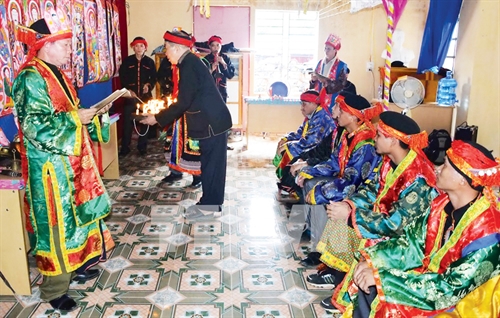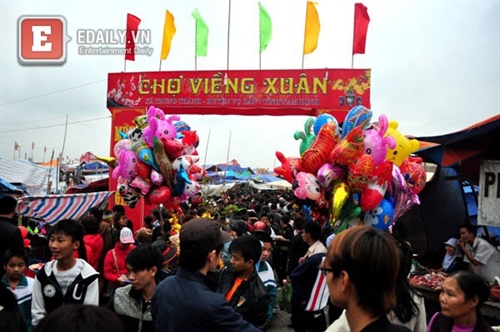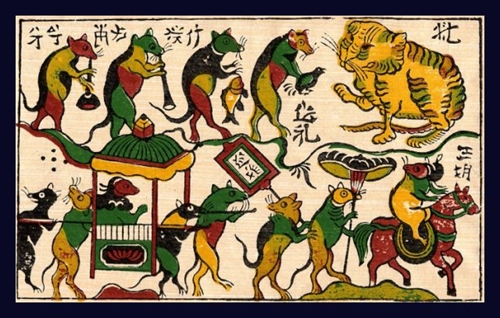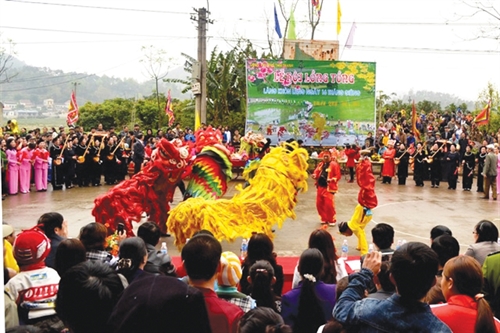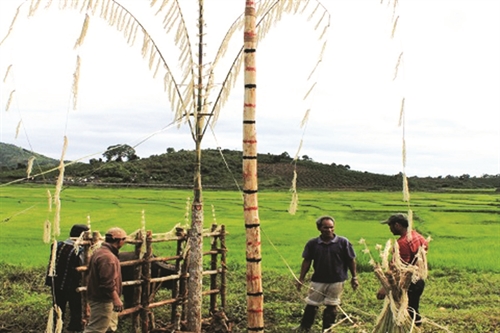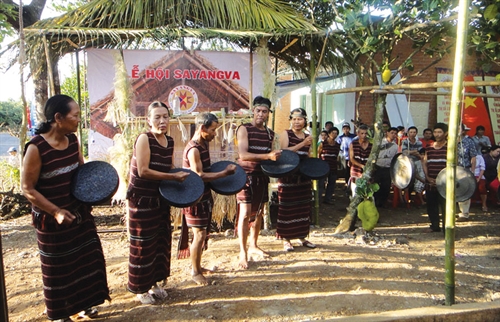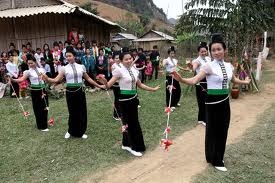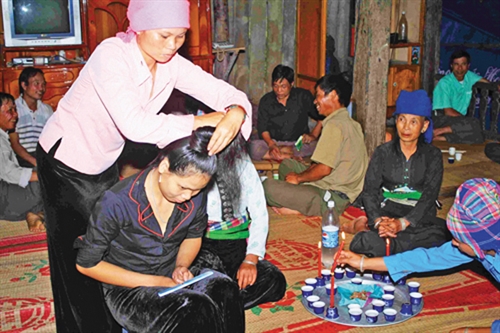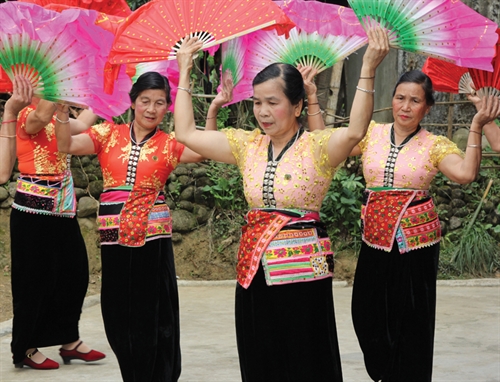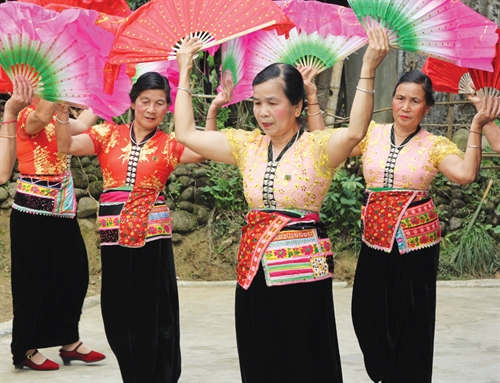Ta Thi Tam
Ethnology Institute
Gau Tao is a unique festival of the H’Mong ethnic minority in Vietnam, which is held after Tet (lunar new year festival) and lasts for 3-4 days. There are several reasons for holding the event, primarily praying for having a boy, many children or health for children. The festival is also organized for bumper crops and favorable weather. A special feature of this festival is that it is not held by the village but a single household, so that there could be a number of Gau Tao festivals held in the year.
The event consists of two main parts: the ritual and the festival. The ritual is for the organizing household and the festival is for the guests as well as villagers. The ritual includes the “cay neu” (bamboo pole) cutting and erecting ceremony and the festival opening and closing ceremonies.
 |
Joyful H’Mong women in Gau Tao festival in Phong Tho district, Lai Chau province__Photo: VNA |
According to the H’Mong belief, bamboos are used in the group’s rituals to connect the living world and the dead’s world or the ancestors, the dead and their offspring. The group thinks that their ancestors’ souls and ghost soldiers can return from the super natural world to help sorcerers catch ghosts, kill monsters and find the souls for the sick.
The bamboo pole cutting and erecting ceremony
The head of the organizing household selects a good day, which does not coincide with his birthday, at the end of the first lunar month, to organize the bamboo pole cutting ceremony. In the early morning of that day, at the invitation of the head of the organizing household, “father Tao”, who is usually a prestigious villager, and father Tao’s wife called “mother Tao” come to his house and pray in front of his ancestors’ altar for the success of the ceremony and the festival.
Then, father Tao, followed by his wife and six helpers from the organizing household goes to the forest to choose a high and straight bamboo tree with a lot of sprouts, called the female bamboo tree, with its top pointing to the east, and a smaller bamboo tree, called the male one, growing in a place that is higher than the house of the organizing household. Before 7 a.m., they make an offering meal for the bamboo tree goddess and the mountain god. The offerings placed facing the east include a boiled rooster, a ceramic pot of maize flour and maize wine. During the offering rite, they sing a song about the reason for making “cay neu” while walking round the selected bamboo trees six times. As soon as the song ends, each member of the team gives the bamboo trees one chop.
The team, led by father Tao, carry the bamboo poles on their shoulders directly to the top of the hill chosen for holding the festival. The female and male bamboo poles are tied together with linen strings into one bamboo pole for the festival, which is a symbol of lingaism. The bamboo pole then will be erected on the ground with the top leaning to the east and decorated at three parts. With nine branches spreading out like a dragon tail, the top of the bamboo pole is tied with two strips of black and red cloth as a flag. The middle part of the pole is hung with a bamboo cylinder or gourd of liquor and three corncobs (or three handfuls of rice in places where upland rice is grown) and some crossbars are tied underneath for hanging panpipes, umbrellas, swords and wood sticks. At the foot of the bamboo pole, there is a table with offerings, including a boiled rooster, an earthen pot of maize flour (or of rice) and joss sticks.
The upper part of the male bamboo pole is also decorated with a handful of linen trees or ferns. The H’Mong prays for nine baby boys and eight baby girls when they hang such trees.
During the bamboo pole erecting ceremony, father Tao and his wife go around in a circle six times, three times in the direction of the sunrise and the others in the direction of the sunset to pray for health and children.
The festival opening ceremony
The formality to open the festival is a singing performance given by father Tao, his wife and six helpers of the organizing family. Particularly, they are also joined by four girls carrying sticks, four boys carrying panpipes and many villagers carrying props. While singing, they walk six rounds of the bamboo pole. In each round, father Tao and his wife touch the pole with the hope of receiving the sacred energy while the others hang handfuls of red or white and black linen strings on the pole. When the song is over, those who wish for their children’s health take these linen strings home and tie around their children’s neck and wrists as they believe the power of the bamboo pole god will protect them.
“Chu Gau Tao”, the most attractive singing performance of the festival, attracts a large number of participants. They are from different groups of age, unmarried young men and women, widows and widowers and those who loved each other but cannot get married. Men and women sit on opposite sides with the bamboo pole is in the middle. Despite their age and circumstances, with an umbrella in their hand, men proactively approach their partners to invite them to sing. If the invited woman agrees, she will take the umbrella and sing with him and if she refuses, she will close the umbrella and leave.
During the festival, various activities take place on the hill, including martial art performance, crossbow shooting, top playing, danh yen (a game similar to badminton with the shuttlecock made of bamboo stuck with some feathers), and nem pao (throwing a colorful cloth ball between teams).
The festival closing ceremony
On the afternoon of the last day of the festival, father Tao, his wife and six helpers of the organizing family organize a ceremony to take down cay neu. Like the bamboo pole setting up ceremony, the team is not supposed to let the bamboo pole touch the ground. They carry the pole to the house of the organizing family, singing the song “Xin mo cua” (Please open the door) in front of the house. The pole, which is expected to bring the sacred energy to the house, is put under the rear roof of the house with its end pointing to the kitchen. The strips of black and red cloth are handed to the wife to make children’s clothes. The pole will later be split to make bed slats for a couple wishing for children.-(VLLF)
